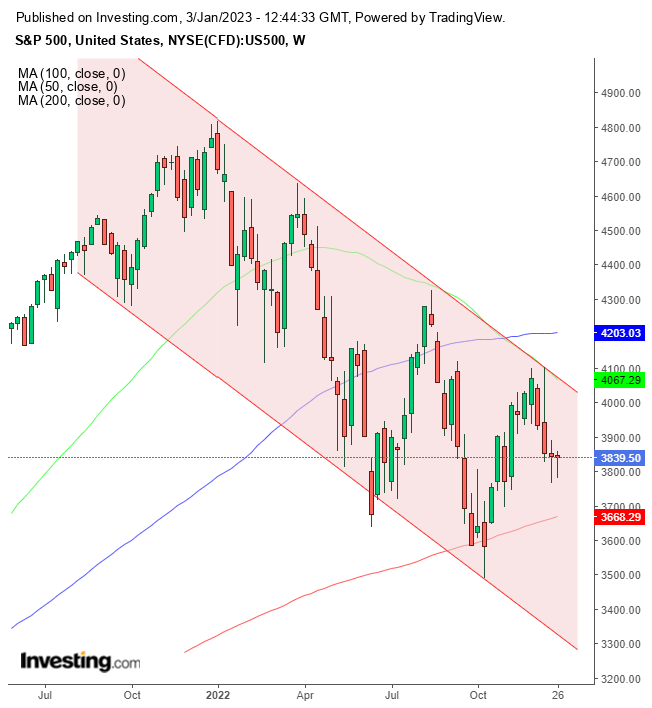- Optimism is fueled by signs of recovery in China and a drop in German unemployment
- However, new travel restrictions and testing requirements for travelers from China could potentially dampen market sentiment
- The S&P 500 Index is forming a pennant, a continuation pattern that is typically bearish after a drop, and I predict a further drop of 300 points from the breakout point
- Entry: 3,850
- Stop-Loss: 3,900
- Risk: 50 points
- Target: 3,550
- Reward: 300 points
- Risk-Reward Ratio: 1:6
Financial markets have started the year off positively, with stocks and Treasuries gaining and the dollar rising. Signs of a recovery in China, a drop in German unemployment, and expectations that the Federal Reserve will slow its rate hikes helped fuel this optimism. Analysts are hopeful that supply chain issues in China will continue to ease, which could bring down global inflation and help China's recovery to get back on track.
However, the news that the Australian government ignored the advice of its Chief Medical Officer and imposed new testing requirements for travelers coming from China, despite a lack of evidence of a new variant emerging from the country, could potentially dampen this positive sentiment.
Many countries, including the U.S., U.K., and other parts of Europe and Asia, have imposed restrictions on travelers from China and its territories in the past week, requiring either pre-departure testing or testing on arrival.
These measures have been controversial, with health experts and scientists warning that they are largely ineffective at preventing the spread of COVID or new variants and could stoke racism and xenophobia. China has warned that it will take countermeasures against these travel restrictions, stating that they lack scientific basis and are "unacceptable." There is currently no evidence of a new variant emerging from China, and experts have pointed out that even if one were to arise, it would likely spread across the world.
I remind you not to "put too much stock" into daily news reports. The S&P 500 index represents the long-term view of the U.S. stock market.

The trend is down. The 50-week MA crossed below the 100 WMA at Oct. end, even as the index was rallying. Here's how to solve this paradox: the rally was in the short term, while the weekly MAs were in the long term. While some traders were buying the dip, there was a greater selling force for the period, warning that the rally was merely in the short term. I have been bearish on the S&P 500 since May when it topped out, a call I repeated numerously.
In my Nov. post, I discussed the rising wedge, which has been completed since.

Now, the S&P 500 is forming a pennant, a continuation pattern, bearish after the 7% plunge in a single swoop amid five straight red days between Dec. 13, when the index failed to post above Dec. 1, and the channel top and the Dec. 19 low.
The pennant's bearish implication is reinforced by the fact that it follows a rising wedge, confirming the falling channel.
The pennant is complete with a downside breakout, demonstrating that the brief equilibrium - when buyers and sellers intensely trade - is over and that the initial drop will resume.
Technicians measure the drop before the range of the pennant and target another such move to the pattern's downside from the breakout point. In this case, the action should statistically take another 300 points down from the breakout point.
Trading Strategies - Short Position Setup
Conservative traders should wait for the price to close below the Nov. 3 trough and then for a return move to confirm the pattern's integrity.
Moderate traders would wait for the S&P 500 to close below the pennant's lowest part, then wait for a rally for a closer entry.
Aggressive traders can short according to their strategy. Here's a generic example:
Trade Sample - Aggressive Short Position
Disclosure: The author does not own any of the securities mentioned in this article.
